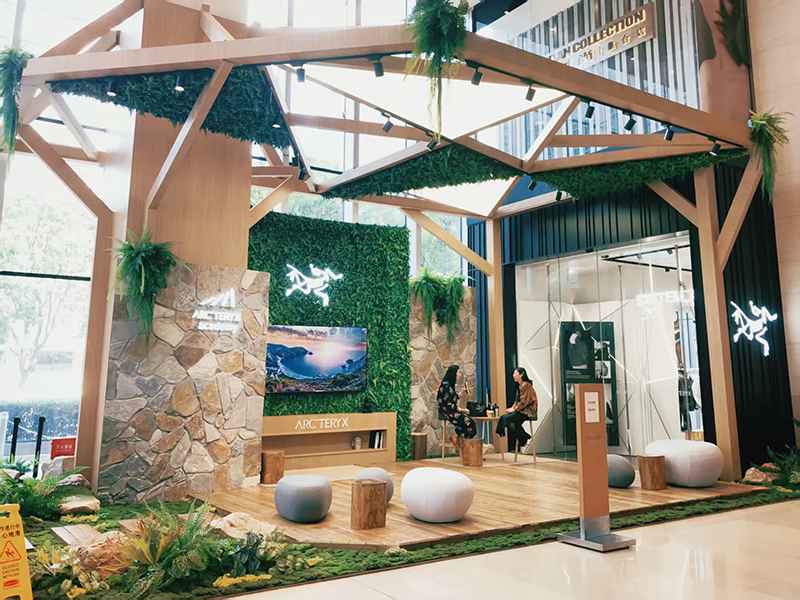The production method of small 3D artificial vertical gardens needs to combine the spatial characteristics and plant requirements, and achieve efficient utilization through modular design, material selection and structural construction. The following is a specific analysis:
Clarify functional positioning: Consider whether it is necessary to set up functional areas such as leisure zones and planting zones. Given the limited space, the functional Settings should avoid being overly complicated, highlighting the core functions to ensure the efficient utilization of the space.
Measure spatial dimensions: Precisely measure the dimensions of walls or balconies to determine the coverage area and shape of the vertical garden, providing a basis for subsequent material preparation and structural design.
Analyze the light conditions: Observe the light conditions at different times of the day to understand the intensity and duration of the light, so as to select suitable plant varieties.
Supporting structure materials: According to the spatial dimensions and load-bearing requirements, select appropriate materials to build the supporting structure, such as metal frames, wooden keels, etc. These materials should have sufficient strength and stability to withstand the weight of plants, substrates and irrigation systems.
Planting containers: You can choose conventional containers such as plastic basins, earthenware basins, and wooden boxes. You can also use materials around you for DIY making, such as coconut shells and plastic bottles. The planting containers should have good drainage performance to prevent water accumulation from causing root rot of the plants.
Planting substrate: Select a lightweight, breathable and water-retenable planting substrate, such as a mixture of peat soil, coconut coir, perlite, etc. This substrate can not only meet the growth needs of plants, but also reduce the burden on the supporting structure.
Plant materials: Select suitable plant varieties based on light conditions and spatial characteristics. Give priority to choosing plants that are suitable for the local climate conditions. Consider the growth habits of the plants and make scientific combinations. Plant sun-loving plants in areas with abundant sunlight and shade-tolerant plants in shady places. At the same time, plants with different flowering periods should be reasonably combined to ensure that there are flowers to enjoy in the garden all year round. In addition, choosing some plants that grow slowly and have compact shapes can effectively prevent the garden from becoming crowded in a short period of time.
Irrigation system materials: Prepare materials such as drip irrigation pipes, drippers, water pumps, and water storage tanks to build an irrigation system, achieve precise water supply, and avoid water waste.
Protective materials: such as waterproof membranes, waterproof coatings, etc., are used to protect walls or balconies from moisture erosion.
Build the support structure: According to the design drawings, assemble and fix the support structure materials to ensure the structure is firm and horizontal and vertical. During the construction process, it is necessary to pay attention to leaving space for irrigation pipes and plant growth.
Install the planting containers: Fix the planting containers on the support structure in a certain arrangement. Hooks, screws and other fasteners can be used. Appropriate spacing should be maintained between containers to facilitate plant growth and ventilation.
Fill the planting substrate: Fill the planting container with the prepared planting substrate. The filling height can be adjusted according to the growth needs of the plants. After filling, gently press the substrate to make its surface smooth.
Planting plants: Carefully remove the selected plants from their original POTS, and try to keep the soil around the roots as much as possible. Dig a suitable pit in the planting container, place the plants in the pit, fill it with substrate and gently compact it. After planting, water thoroughly in time to help the plants establish roots.
Install the irrigation system: According to the layout of the support structure and planting containers, install the drip irrigation pipes and drippers. Connect the water pump to the water storage tank and set the irrigation time and water volume to ensure that the plants can receive sufficient water supply.
Set up a protective layer: Lay waterproof membranes or apply waterproof paint between the wall or balcony and the vertical garden to prevent water seepage. Meanwhile, sunshade nets or windbreak nets can be set up on the top of the vertical garden to protect the plants from extreme weather.
Add decorative elements: Place some artistic ornaments in the vertical garden, such as small and exquisite sculptures, birdcages with a retro charm, etc., to enhance the artistic style of the garden. Solar ground lamps can also be arranged along the path, and some string lamps can be placed among the plants to create a warm and romantic atmosphere.
Place outdoor furniture: According to the size of the space, place some comfortable outdoor furniture, such as folding chairs and small coffee tables, to facilitate rest and enjoying the beautiful garden scenery.

Contact: Amy
Phone: 86-15311787313
E-mail: info@foszmac.com
Whatsapp:86-15311787313
Add: Fengtai District, Dacheng Road, No.24 Building, Room 203, Beijing, China